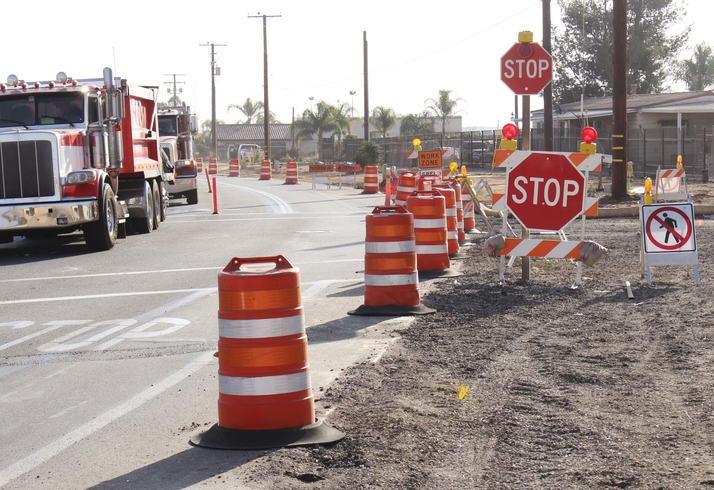Prevent work zone car accidents with these tips

On highways, main streets, and back roads, work zones are everywhere this time of year. Although necessary for the sake of smooth, safe roads, the temporary construction sites change traffic patterns, create congestion, and increase the risk of bad car accidents.
Work zones separate construction and maintenance workers from traffic. Orange cones, jersey barriers, workers in hard hats and bright vests are hallmarks of these areas. Regionally, there are thousands of serious work zone wrecks each year. Dozens of these accidents are fatal.
Recht Law Offices has successfully handled enough injury claims and lawsuits to know that despite some effective state and federal attempts to make work zones safer, they are still incredibly dangerous.
To improve conditions and raise awareness about the problem, the Federal Highway Administration launched the “Drive Safe. Work Safe. Save Lives.” campaign. Part of the effort provides drivers with advice about how to maneuver safely through construction zones.
Roadway work zone safety
Work zone accidents have been declining in Pennsylvania for years following a high point in 2016 when there were more than 2,000 crashes. That number dropped to 1,400 such accidents in 2020. Fatal accidents declined too. In fact, over the last two decades, 2020 had the fewest work zone-related car accident fatalities with 15 deaths. Yet, there is still more work to be done.
To improve safety in work zones, the Federal Highway Administration offers these suggestions to motorists.
Avoid work zones, if possible.
The best way to not get into a car accident in a work zone is to not drive in a work zone. This is not always possible, but if you can plan an alternate route, do so to reduce your risk of getting in a crash. To check if there is construction on your intended path, you can enter your starting point and destination into Google Maps. On the map that is generated for you, look for the “construction zone” symbol - a shoveling man on a yellow circle - to see where roadwork is being done. The map will also give you real-time traffic flow information. Google will tell you about major road projects, but smaller work zones for things like resurfacing or tree pruning may not appear.
Don’t make assumptions.
Even if you’ve traveled through the same work zone multiple times, do not assume that you know what to expect. Work zones change constantly as various project layers are completed and contractors move down the road. Stay alert and drive with caution.
Watch for workers.
Don’t just look for workers in your direct path; be aware of what they are doing nearest to the traffic too. If you think there is potential for the worker to accidentally put any part of their body into traffic, slow down. In 2019, there were 135 workers killed in highway work zones nationwide.
Be prepared for sudden stops.
In a construction zone, things can change quickly. Traffic may stop seemingly out of nowhere. The Pennsylvania Department of Transportation suggests that drivers leave double the space when traveling in construction zones than they would normally maintain from the vehicle in front of them. This will allow extra time to stop.
Slow down.
In almost every situation, the faster a car, pickup truck, SUV, or motorcycle is going at the time of a crash, the greater the damage and injuries. Most work zones require drivers to decrease their speed. Traffic violation penalties are often doubled in work zones as well. Speed was a contributing factor in nearly one-third of all work zone accidents in 2019.
Be careful around large vehicles.
Large commercial trucks and tractor-trailers are everywhere, especially on highways. Never attempt to pass a truck when you are close to or in a work zone. Due to their size and weight, trucks cannot stop as quickly as a sedan or other passenger vehicle – you need to leave plenty of space between you and the truck. Semis also have significant blind spots; you don’t want to be in one of those if a big rig has to suddenly make a lane shift due to construction.
After a bad accident, turn to Recht Law Firm
When there’s a serious work zone crash, the people most likely to be injured or die aren’t workers; they are drivers, passengers, pedestrians, and bicyclists.
If you or a loved one was hit by a car in a work zone, you are likely entitled to compensation from the at-fault person(s) for your medical bills, pain and suffering, property loss, and other damages.
Even if you feel like your injuries are minor, you should consult with a personal injury lawyer who can help you understand how seemingly minor injuries can get worse over time and require later-in-life or ongoing treatment.
You are likely only going to get one shot to collect a crash settlement. You can't go back and ask for money if, in 2, 5, or 10 years from now, your injury has progressed and is now preventing you from working or limiting your mobility, or requiring surgery.
Out of pocket costs for medical treatment are astronomical. About 40% of working-age Americans are in medical debt or struggling to pay for treatment. Don't let someone else's negligence cause your family to struggle with finances for years to come.
Attorneys Steven M. Recht and Elisa Recht Marlin grew up in Weirton, West Virginia, and understand how laws in the tri-state area apply to car accidents and victims’ rights.
Our law firm can aggressively advocate for your best interests and fight for the compensation you need and deserve.
Contact us at our Weirton, WV, or Pittsburgh, PA office to schedule a free consultation today.
